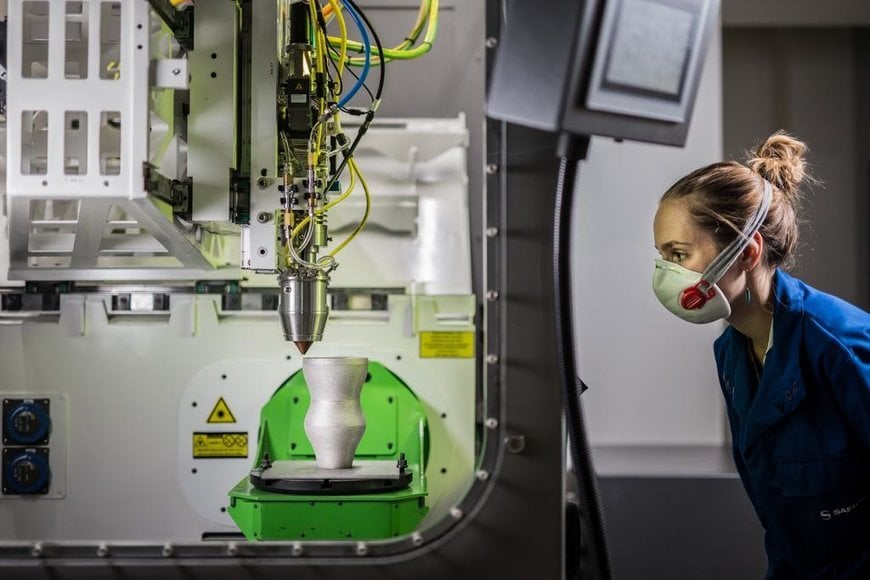www.magazine-industry-usa.com
07
'22
Written on Modified on
Safran Engineering Services: An expert in additive manufacturing with a focus on customers
Gérard Coumes, Head of Innovation and New Services Department in Toulouse, Juan Antonio Marchán, Head of Additive Manufacturing in Spain, and Fabrice Rusch, the Bordeaux site manager for Safran Engineering Services, explain to us the benefits and challenges of this new-generation manufacturing process.

Since 2016, Safran Engineering Services has been developing many services related to additive manufacturing, including material test plans, topology optimizations, support for the development of adapted products, and parts manufacturing.
The process involves a laser beam used to form a melt pool on a metallic substrate, into which powder is fed. The powder melts to form a deposit that is fusion bonded to the substrate.
Additive manufacturing: Basic principle
The principle of additive manufacturing seems a simple one: To create parts starting from a digital object, using a laser beam to add material. “Additive manufacturing lets us manufacture in the same way that nature does,” Juan Antonio Marchán says. The shape isn't determined by any mold; we can design more organic and complex structures. Implementing it therefore requires a real paradigm shift in the industry. Machines, materials and even the way parts are designed are evolving in step with this process,” he explains.
Safran Engineering Services started working on the subject in 2016. Its early work enabled it to develop strong expertise in this area, which the company is now making available to its customers. As Gérard Coumes explains, “We wanted to establish the use cases in which additive manufacturing could be useful, and we found that there was a real benefit to combining it with a number of services that we offer.”
Additive Manufacturing: Technology with Multiple Benefits
With traditional manufacturing, in order to obtain first a part, and then a subsystem, various different elements must be assembled; these will have been manufactured separately or using special molds. Machining phases, such as turning and milling, will also be necessary. By contrast, additive manufacturing makes it possible to overcome machine-related constraints. It then becomes possible to create complex parts with innovative shapes, while at the same time reducing assembly and maintenance times.
One of the projects being run by Safran Engineering Services is the topological optimization of existing products or subsystems. This involves rethinking the shape of parts and calculating the resulting savings in terms of size and mass. “Our customers come to us with a challenge,” Gérard explains, “and we help them to take advantage of all the benefits of additive manufacturing. Savings in mass, for example, can be as high as 50% for some parts! ”
Additive manufacturing: specific uses at Safran Engineering Services
The benefits of additive manufacturing depend on criteria such as the shape of the parts, options for using other materials, or the potential for economic savings. Safran Engineering Services therefore regularly conducts studies on behalf of its customers in order to identify eligible candidate parts.
“Over the years, we have established very close synergies with our partners, whether they are publishers of design software or the part manufacturers themselves,” Gérard continues. So we are now able to support our customers throughout their projects, from development to initial specification, through design, test plans for materials, up to the delivery of final parts. ” Additive manufacturing is also an attractive solution for prototyping, verification of concepts or production of short runs of parts. Given that the shape of the parts is determined via a computer program, and not a mold, this technology makes it possible to manufacture more quickly, in small quantities and at more competitive prices.
Towards a new way of designing industrial parts
The use of additive manufacturing, however, involves rethinking traditional processes. For example, a “design thinking” approach is needed. Seen from this angle, the design of a new part requires consideration ahead of time of how it will be manufactured. For example, its future environment and restrictions must be considered in order to select the appropriate materials or plan for any appropriate surface treatments. This is a stage at which Safran Engineering Services – a specialist in designing products and systems for the transport industry – can offer strong added value. “We offer our customers a different perspective, facilitating their accelerated transition to additive manufacturing,” Juan Antonio explains.
The nerve center of Safran's additive manufacturing activities
Safran Engineering Services is currently helping to enhance the maturity of Safran Additive Manufacturing Campus, a subsidiary and site bringing together all of Safran's activities related to additive manufacturing, the aim of which is to produce all of the Group's parts made using this technology. It is assisting the new entity in achieving its various production engineering milestones. “We are supporting the work of Safran Additive Manufacturing Campus in several areas: Manufacturing sequences, tooling design, project management, R&T for materials and manufacturing processes,” Fabrice Rusch explains.
Via this structure, Safran can control all the parameters related to additive manufacturing. In doing so, the Group is helping to make this technological innovation a key part of the industrial standards of tomorrow, both within its own companies and among its customers and partners. And in terms of those standards, Safran Engineering Services is a true flag-bearer.
www.safran-group.com

